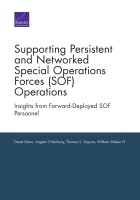| 来源类型 | Research Reports
|
| 规范类型 | 报告
|
| DOI | https://doi.org/10.7249/RR1333
|
| ISBN | 9780833092540
|
| 来源ID | RR-1333-USSOCOM
|
| Supporting Persistent and Networked Special Operations Forces (SOF) Operations: Insights from Forward-Deployed SOF Personnel |
| Derek Eaton; Angela O'Mahony; Thomas S. Szayna; William Welser IV
|
| 发表日期 | 2017
|
| 出版年 | 2017
|
| 页码 | 48
|
| 语种 | 英语
|
| 结论 |
Researchers' Findings Spanned Three Operational Challenges for Special Operations Forces- Special operations forces (SOF) and the U.S. Department of State do not integrate their processes as much as they could. SOF teams' mission effectiveness appears greater when there is transparency and trust in teams' interactions with the embassy country team. Integration could also improve between SOF teams.
- Short-duration deployments coupled with poor to nonexistent documentation for subsequent teams have resulted in dropped products and degraded teams' ability to build on past efforts.
- The most challenging, mission-critical contract that SOF personnel negotiate appears to be for hiring interpreters. Funding processes generally also frustrate SOF personnel. And many teams found that the foreign disclosure and vetting processes for foreign personnel took longer than the team had expected, which has led to canceled training missions.
- In addition to these unity- and continuity-of-effort and administrative complexity challenges, researchers found inefficiencies and incongruity in information-sharing between SOF and partner-nation (PN) forces, in PN equipment for training and exercises, in lacking language capabilities upon deployment, in failed or insecure communication capabilities and equipment, and in body armor that can be worn less visibly when wearing civilian attire for meeting with local leaders.
|
| 摘要 |
- Add personnel with both U.S. Special Operations Command (USSOCOM)– and geographic combatant command–specific backgrounds to the theater special operations commands (TSOCs).
- Ensure that TSOCs are large enough to be effective, to provide continuity between deployments, to support SOF personnel administratively, and to coordinate with other agencies.
- Leverage SOF liaison elements, such as SOF liaison elements and liaison officers, to improve unity and continuity of effort.
- Stagger deployments of key personnel.
- Use the National Security Decision Directive 38 process to formalize relations with chiefs of mission.
- Include SOF and geographic combatant commander planning within broader U.S. strategic planning at the country level, preferably through the mission strategic resource planning process.
- Educate SOF and the interagency about their respective activities, capabilities, and responsibilities.
|
| 主题 | Military Command and Control
; Military Force Deployment
; Security Cooperation
; Special Operations Forces
|
| URL | https://www.rand.org/pubs/research_reports/RR1333.html
|
| 来源智库 | RAND Corporation (United States)
|
| 引用统计 |
|
| 资源类型 | 智库出版物
|
| 条目标识符 | http://119.78.100.153/handle/2XGU8XDN/108590
|
推荐引用方式
GB/T 7714 |
Derek Eaton,Angela O'Mahony,Thomas S. Szayna,et al. Supporting Persistent and Networked Special Operations Forces (SOF) Operations: Insights from Forward-Deployed SOF Personnel. 2017.
|
|
文件名:
|
x1508173792866.jpg
|
|
格式:
|
JPEG
|

|
文件名:
|
RAND_RR1333.pdf
|
|
格式:
|
Adobe PDF
|
除非特别说明,本系统中所有内容都受版权保护,并保留所有权利。